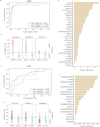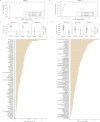Maternal plasma cell-free RNA as a predictor of early and late-onset preeclampsia throughout pregnancy
- PMID: 41115885
- PMCID: PMC12537965
- DOI: 10.1038/s41467-025-64215-2
Maternal plasma cell-free RNA as a predictor of early and late-onset preeclampsia throughout pregnancy
Abstract
Early- and late-onset preeclampsia (EOPE and LOPE) pose serious maternal-fetal risks, yet non-invasive early prediction remains challenging. In a prospective cohort of 9,586 pregnancies, we analyze trimester-specific plasma cell-free RNA (cfRNA) profiles from 42 EOPE and 43 LOPE cases versus 131 normotensive controls. Organ-specific transcriptomic shifts distinguish EOPE from LOPE. Predictive models based on cfRNA signatures identify EOPE up to 18.0 weeks before clinical onset in the first-trimester (T1) (AUC = 0.88), and 8.5 weeks in the second trimester (T2) (AUC = 0.89). LOPE is predicted 14.9 weeks in advance using T2 data (AUC = 0.90), while T1 performance is lower (AUC = 0.68). External validation confirms robust EOPE prediction (AUC = 0.87 at T1; 0.81 at T2) and acceptable LOPE performance (AUC = 0.63 at T1; AUC = 0.77 at T2). EOPE models are enriched for decidual transcripts, suggesting early maternal involvement; LOPE models reflect broader tissue contributions. These findings offer a path to early, non-invasive, subtype-specific preeclampsia risk stratification and prevention.
© 2025. The Author(s).
Conflict of interest statement
Competing interests: N.C-M., M.I., T.G-G., C.S. are inventors on a patent application (EP24383276.3) covering methods for determining the risk of preeclampsia. N.C-M., T.C., M.I., C.G-A., N.B-G., A.G-D., E.O-D., A.V., T.G.-G. are employees of iPremom Pregnancy Healthcare Diagnostics. C.S. is a founder of iPremom Pregnancy Healthcare Diagnostics. The remaining authors declare no conflict of interest.
Figures





References
-
- Organization WH. 2018 Global Reference List of 100 Core Health Indicators (plus health-related SDGs). (WHO, 2018).
-
- Say, L. et al. Global causes of maternal death: a WHO systematic analysis. Lancet Glob. Health2, e323–e333 (2014). - PubMed
-
- Moreno, I. et al. The human periconceptional maternal-embryonic space in health and disease. Physiol. Rev.103, 1965–2038 (2023). - PubMed
-
- ACOG Practice Bulletin No 202 Summary: gestational hypertension and preeclampsia. Obstet. Gynecol.133, 1 (2019). - PubMed
MeSH terms
Substances
LinkOut - more resources
Full Text Sources

